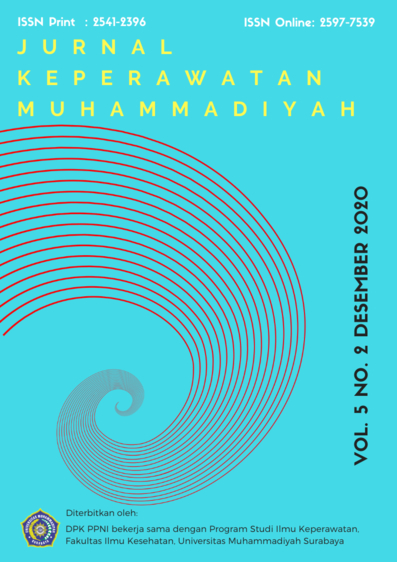Pengaruh PEEP Terhadap CVP pada Pasien yang terpasang Ventillator Mekanik : Literatur Review
DOI:
https://doi.org/10.30651/jkm.v5i2.4816Keywords:
PEEP, CVP, VentilatorAbstract
The purpose of this literature review is to discuss PEEP (Positive End Ekspiratory Pressure) and CVP (Central Venous Pressure) in patients who have ventilators. Adequate interpretation is needed by nurses who make direct observations about the patient's actual volume status without the influence of expiratory end pressure due to the administration of PEEP to patients who are attached to a ventilator. Study of this literature through a search of scientific publications using the database Pubmed, Google Scholar, Science Direct. Pubmed. Criteria for inclusion of this research article on PEEP and CVP in patients who are ventilators with publications between 2010-2017. This study shows that the effect of changing CVP values greatly influences hemodynamics and fluid status in the patient's body and determines the next interventions that will be given to patients so that changes in CVP values with PEEP in patients who are fitted with mechanical ventilators are needed in order to determine a meaningful CVP value. Based on this description, it is recommended that research studies related to changes in the conversion of CVP values with PEEP.References
Alligood, M. R. (2014). Nursing Theorist and Their Work (Eight Edit). Elsevier Inc.
Arthur, M. E., Landolfo, C., Wade, M., & Castresana, M. R. (2009). Inferior Vena Cava Diameter (IVCD) Measured with Transesophageal Echocardiography (TEE) can be used to derive the Central Venous Pressure (CVP) in anesthetized mechanically ventilated patients. Echocardiography, 26(2), 140–149. https://doi.org/10.1111/j.1540-8175.2008.00772.x
Baid, H. (2016). Patient Safety: Identifying and Managing Complications of Mechanical Ventilation. Critical Care Nursing Clinics of North America, 28(4), 451–462. https://doi.org/10.1016/j.cnc.2016.07.005
Bardossy, G., Hala’sz, G., & Gondos, T. (2011). The diagnosis of hypovolemia using advanced statistical methods. Elsevier, 41, 1022–1032. https://doi.org/10.1016/j.compbiomed.2011.09.002
Cairo, J. M. (2013). Mechanical Ventilation Phisiology and Clinical applications. In Ecosystems and Human Well-being: A Framework for Assessment (Sixth Edit, Vol. 12, Issue 16). Elsevier.
Ferrando, C., Mugarra, A., Gutierrez, A., Carbonell, J. A., GarcÃa, M., Soro, M., Tusman, G., & Belda, F. J. (2014). Setting individualized positive end-expiratory pressure level with a positive end-expiratory pressure decrement trial after a recruitment maneuver improves oxygenation and lung mechanics during one-lung ventilation. Anesthesia and Analgesia, 118(3), 657–665. https://doi.org/10.1213/ANE.0000000000000105
Fougères, E., Teboul, J.-L., Richard, C., Osman, D., Chemla, D., & Monnet, X. (2010). Hemodynamic impact of a positive end-expiratory pressure setting in acute respiratory distress syndrome: Importance of the volume status*. Critical Care Medicine, 38(3), 802–807. https://doi.org/10.1097/CCM.0b013e3181c587fd
Geerts, B. F., Aarts, L. P. H. J., Groeneveld, A. B., & Jansen, J. R. C. (2011). Predicting cardiac output responses to passive leg raising by a PEEP-induced increase in central venous pressure, in cardiac surgery patients. Br J Anaesth, 107(2), 150–156. https://doi.org/10.1093/bja/aer125
Hollenbeck, K. J., Vander Schuur, B. M., Tulis, M. R., Mecklenburg, B. W., Gaconnet, C. P., Wallace, S. C., Lujan, E., & Lesnik, I. K. (2010). Effects of Positive End-Expiratory Pressure on Internal Jugular Vein Cross-Sectional Area in Anesthetized Adults. Anesthesia & Analgesia, 110(6), 1669–1673. https://doi.org/10.1213/ANE.0b013e3181da92e4
Jevon, P., & Ewens, B. (2012). Monitoring The Critically Ill Patient (3rd Editio). Blackwell Publishing Ltd.
Lei, Y. (2017). Medical Ventilator System Basics Clinical Guideline. Oxford University Press.
Magder, S. (2006). Central venous pressure: A useful but not so simple measurement. Critical Care Medicine, 34(8), 2224–2227. https://doi.org/10.1097/01.CCM.0000227646.98423.98
Mulyati, T., Fatimah, S., & Susilaningsih, F. S. (2012). Pengaruh Positive End Expiratory Pressure Terhadap Nilai Central Venous Pressure. Majalah Kedokteran Terapi Intensif, 2, 119–124.
Pasion, E., Good, L., Tizon, J., Krieger, S., O’Kier, C., Taylor, N., Johnson, J., Horton, C. M., & Peterson, M. (2010). Evaluation of the monitor cursor-line method for measuring pulmonary artery and central venous pressures. American Journal of Critical Care, 19(6), 511–521. https://doi.org/10.4037/ajcc2010502
Scales. (2010). Central venous pressure monitoring in clinical practice. Nursing Standard, 24. https://doi.org/10.7748/ns2010.03.24.29.49.c7629
Scott, S., & Giuliano, K. K. (1998). Influence of Port Site on Central Venous Pressure Measureents from Triple lumen Catheters in Critically Ill Adults. American Journal of Critical Care, 7(February 1998), 60–63. https://doi.org/10.4037/ajcc1998.7.1.60
Shojaee, M., Sabzghabaei, A., Alimohammadi, H., Derakhshanfar, H., Amini, A., & Esmailzadeh, B. (2017). Effect of Positive End-Expiratory Pressure on Central Venous Pressure in Patients under Mechanical Ventilation. Emergency (Tehran, Iran), 5(1), e1.
Sinto, R., & Suwarto, S. (2014). Parameter Akhir Resusitasi Makrosirkulasi dan Mikrosirkulasi pada Sepsis Berat dan Renjatan Septik. Jurnal Penyakit Dalam Indonesia, 1(1).
Suresh, M. R., Chung, K. K., Schiller, A. M., Holley, A. B., Howard, J. T., & Convertino, V. A. (2018). Unmasking the Hypovolemic Shock Continuum : The Compensatory Reserve. Journal of Intensive Care Medicine, 1–11. https://doi.org/10.1177/0885066618790537
Tol, G., & Palmer, J. (2010). Principles of mechanical ventilation. Anaesthesia and Intensive Care Medicine, 11(4), 125–128. https://doi.org/10.1016/j.mpaic.2010.01.002.
Downloads
Published
Issue
Section
License
- Penulis tetap memegang hak atas karyanya dan memberikan hak publikasi pertama kepada jurnal ini yang secara simultan karya tersebut dilisensikan di bawah:Â Creative Commons Attribution-ShareAlike 4.0 International (CC BY-SA 4.0)













